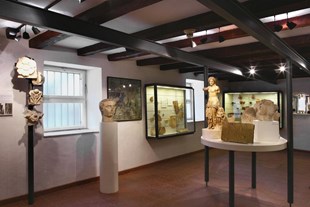The Early Medieval Period
- Permanent exhibition
The early medieval period (from the early 7th to the end of the 11th centuries) is presented in the fourth and sixth rooms. The fourth room displays early Croatian grave goods... More

| Phone | 385 23 264 726; 385 23 264 160 |
| Fax | 385 23 264 210 |
No data.
No data.
The first mention of archaeological excavations around the city of Nin is dated to 1777, when small areas were dug at positions to the west of the small island on which the city is located. At the end of the 19th century, excavations in the Nin area reached their apex, thanks to the activities of Mihovil Glavinic. His example was continued by Mon. Luka Jelic, who saw to it that a collection of stone monuments (the "Antiquities Collection") was put on display in 1910 in the Church of the Holy Cross. Fragments of early medieval church furnishings predominated among the stone monuments on display.
In 1958, the Peoples' Committee of the Nin District assigned the present museum building to the Archaeological Museum in Zadar to display and store material and monuments; renovation of the ruinous building began in the same year, and on the 2nd of May 1960, the first permanent exhibition was opened of the "Regional Collection of Nin". For the first time, archaeological material from the prehistoric, Roman, amd early medieval periods was displayed.
The permanent exhibition of the collection was modernized in 1970-1971, and new display cases and finds were presented to the public.
In 1991, when the Homeland War started, the archaeological material was evacuated and stored in a safe place, while the stone monuments were protected. After the war, the permanent exhibition was not returned to its former position because of the poor condition of the building, and in 1997, work began on a thorough renovation of the entire museum. Although renovation continued until 2004, the new permanent exhibition was opened on the 7th of June 1999.
The present permanent exhibition, displayed in seven separate rooms, encompasses all the important historical periods related to the development of Nin, with each period divided into several thematic units and accompanied by many archaeological artifacts, legends and texts referring to themes and objects, reconstruction, models, photographs, and plans.
This new conception of the permanent exhibition and organization of the museum meant that the former collection was renamed in 2005, and it is now called the Museum of Nin Antiquities.

The early medieval period (from the early 7th to the end of the 11th centuries) is presented in the fourth and sixth rooms. The fourth room displays early Croatian grave goods... More

A special pavilion was built (room 5) to display the results of the many years of underwater excavations in the region of Nin and at Zaton, where the Roman harbour of Aenona was... More

The stone monuments from Nin and its immediate surroundings are on display in the lapidarium. The collection consists of stone monuments from the Roman, Medieval, and early Modern... More